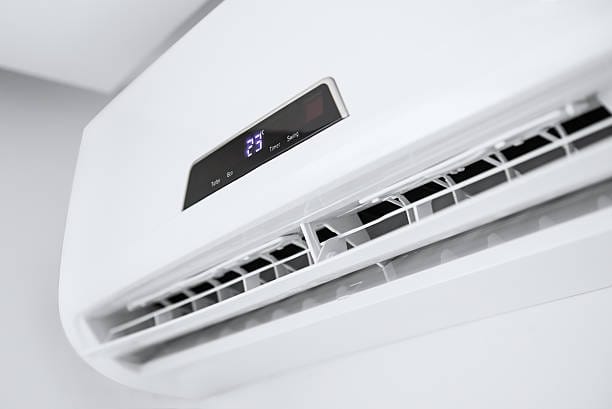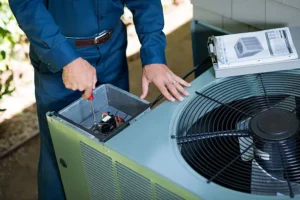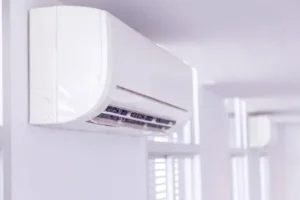Learn quick troubleshooting tips for central air conditioning that’s not cooling properly.
When your central air conditioning system is running but not cooling, it can turn your home into an uncomfortable, stuffy space. Whether you’re facing a complete cooling failure or just a drop in performance, identifying the root cause is essential. This guide will walk you through step-by-step troubleshooting methods to get your AC blowing cold air again.
Check Thermostat Settings
Before drawing any conclusions, start with the basics:
- Check that your thermostat is in cooling mode and adjust the setting so it’s lower than the temperature inside your home.
- Set the fan to “auto.” This allows the fan to operate only when cooling is needed, preventing constant airflow without cooling.
- Inspect the thermostat’s batteries. Weak batteries can lead to thermostat malfunctions.
- Check for the correct mode and temperature display. A malfunctioning thermostat might display inaccurate readings.
If your thermostat is outdated, upgrading to a programmable or smart thermostat can provide more accurate control over your indoor climate.
Inspect Air Filters
Clogged or dirty air filters are often the cause of AC not blowing cold air. Limited airflow can lead to overheating or freezing within the system, which negatively impacts performance.
- Locate the air filter. This is usually found in the return air vent, near the blower, or within the AC unit itself.
- Inspect the filter. If the filter is dirty, replace it with a clean, high-quality one to ensure proper airflow and system efficiency.
- Follow the manufacturer’s recommendations for replacement frequency. In most homes, replacing the air filter every 1 to 3 months helps keep your system running efficiently and the air clean.
Examine the Outdoor Unit
The outdoor condenser plays a key role in your home’s cooling process.
- Ensure the unit is free of debris. Clear leaves, grass clippings, and dirt.
- Inspect the condenser fins. Bent fins can restrict airflow. Use a fin comb to gently straighten any bent fins on the condenser coil, which helps maintain proper airflow and cooling efficiency.
- Check the fan. Make sure it’s spinning freely and doesn’t make unusual noises.
- Clean the condenser coils. Use a garden hose to carefully rinse away dirt buildup on the condenser coils, helping to maintain proper airflow and efficiency.
Assess Refrigerant Levels
Low refrigerant levels are a common reason for central air not cooling. Without enough refrigerant, the system can’t effectively absorb and release heat. Signs of a refrigerant issue include:
- Ice buildup on the evaporator coils.
- Hissing or bubbling noises from the unit.
- Reduced cooling efficiency.
If you suspect a refrigerant leak:
- Do not attempt to refill refrigerant yourself. It requires a licensed HVAC technician.
- Schedule a professional inspection to detect and repair leaks.
Test the Electrical Components
Sometimes, the issue stems from faulty electrical connections.
- Check the circuit breaker. Make sure it hasn’t tripped.
- Inspect the contactor switch in the outdoor unit.
- Look for damaged wiring. Worn or frayed wires can interrupt power.
- Test the capacitor. A failing capacitor may stop the fan or compressor from starting properly.
Evaluate Ductwork and Vents
Your AC might be working perfectly, but if the cool air can’t reach your rooms, it’s ineffective.
- Check for disconnected or damaged ductwork. Leaks can cause cool air to escape, lowering the overall efficiency of the system.
- Ensure all vents are open and unblocked. Make sure that airflow isn’t restricted by curtains, rugs, or furniture placed near vents or returns.
- Inspect for mold or debris buildup in ducts that could restrict airflow.
Inspect the Evaporator Coils
If the evaporator coils become dirty or frozen, they lose their ability to function effectively.
- Access the coils in the indoor unit.
- If the coils are frozen, turn off the system and let them thaw completely before restarting.
- Gently clean the coils using a soft brush or a coil-specific cleaner to eliminate dirt and buildup.
- Make sure the condensate drain is clear. Blocked drains may result in an accumulation of excess moisture.

When to Call a Professional
If you’ve tried these steps and your AC is still not cooling, it may be time to call a professional HVAC technician. You should seek professional assistance in situations such as:
- Refrigerant leaks that need to be sealed and refilled.
- Electrical issues like faulty wiring or a failing capacitor.
- Compressor malfunctions can hinder the system’s ability to cool your home efficiently.
- Age of the system. If your AC is 10 to 15 years or older, replacing it might be more economical.
Conclusion
Your central air conditioning system should keep your home cool and comfortable, especially during hot summers. When it’s running but not cooling, don’t panic. Consult this guide to help diagnose and fix common air conditioning issues.
If the problem persists, On Point Service Company is here to help. Our experienced technicians can quickly diagnose and repair any AC problem, ensuring your home stays cool and comfortable. For professional air conditioning repair, visit On Point Service Company.







